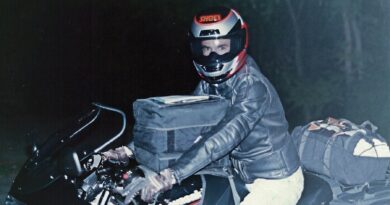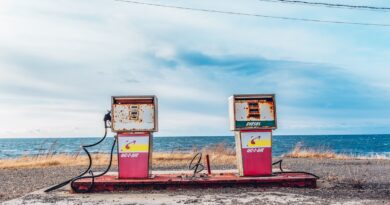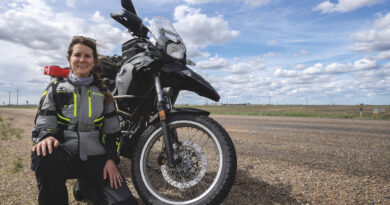Too much adventure?
 I just returned from the most challenging trail ride of the past year. My on-road/off-road ratio shifts back and forth, and pavement got the lion’s share of 2020’s saddle time. Hence, it was with a mixture of dirt-starved excitement and rusty apprehension I set out to explore once-familiar routes at my local OHV park. It did not go well—or did it? A mountain-biker friend insists a ride can only be considered great if those involved must seriously consider the possibility they won’t make it back. If that’s the criterion, then my ride was truly epic.
I just returned from the most challenging trail ride of the past year. My on-road/off-road ratio shifts back and forth, and pavement got the lion’s share of 2020’s saddle time. Hence, it was with a mixture of dirt-starved excitement and rusty apprehension I set out to explore once-familiar routes at my local OHV park. It did not go well—or did it? A mountain-biker friend insists a ride can only be considered great if those involved must seriously consider the possibility they won’t make it back. If that’s the criterion, then my ride was truly epic.
Eons ago, when I rode at this place often, everyone else doing so was on two wheels. Four-wheelers started showing up with increasing regularity, seemingly because anyone could hop on one and go, skill development be damned. Anecdotal evidence suggested these machines were actually more dangerous than motorcycles, with roll-overs much more consequential for their (usually helmetless) riders. They were also far more destructive to the terrain, partly due to how they work and partly due to how their operators worked them. It became common to see groups taking turns sitting still in soft, wet areas, spinning their wheels gleefully until they had to be dragged out with a winch.
The resulting craters were a huge annoyance to motorcyclists. Not only did they create tediously repetitive dips that added nothing to the enjoyment of riding, but they filled with water, the depth of which was impossible to judge. Many such depressions ended up being 30-50 yards in length. They might be as shallow as six inches or as deep as three feet; their placid surfaces gave no clues. We were forced to treat each one as a potential bike-swallower, skirting their edges as much as possible in extremely tight settings with no alternative paths.
Side-by-sides came to replace the four-wheelers, and their explosive popularity compounded the problems for motorcyclists. Geometrically. These larger, heavier, taller, and more powerful machines have torn up trails—and even jeep roads—at a rate and to a degree previously unimaginable. Whereas trails in this area have always been quite rocky, side-by-side traffic has eroded much of the dirt that supplied at least some reprieve from brutal rock gardens. Steep climbs, which were plenty difficult before, are now complicated even further by the cavernous ruts dug by giant tires hunting traction at full throttle and a snail’s pace.
Trail maintenance, which used to be a strength of this facility, seems to have been altogether abandoned. The side-by-side pilots like things the way they are. They not only constitute the largest contingent of permit-buying customers, but their numbers have doubled and doubled and doubled again. The park, which used to be host to a familiar group of local enthusiasts, now teems with a multitude of visitors from far-flung lands. I used to wonder why, with the enormous increase in revenue, the park didn’t invest in keeping the trails in better shape. Now I understand that the degraded conditions are an asset, not a liability, with the users paying to make the place “better” while the owners build more cabins for them.
Motorcyclists no longer matter, and from a financial perspective, why should we? Aside from my companion on this recent outing, I didn’t see a single other bike in a facility with four gigantic parking lots crammed with trucks and trailers. Times change. I should get over it, but nobody likes to become irrelevant. My ride began with resentment and fearfulness, which are not good starting points, and it got worse from there.
 I would have felt trepidation about this ride, even without the park’s devolution. When I was at my skill and physical conditioning peaks, it was not uncommon to spend a whole day there and travel less than 30 miles, sometimes much less. Bikes and bodies would have been battered, tanks drained, courage and resolve repeatedly tested, and everyone would feel a sense of immense accomplishment at having simply survived. This was considered “fun.” Although I can recall that mindset, I no longer possess it. My buddy and I planned to enter on some relatively easy trails and poke around beyond them until we got too tired, frustrated or intimidated. We would ease into it…
I would have felt trepidation about this ride, even without the park’s devolution. When I was at my skill and physical conditioning peaks, it was not uncommon to spend a whole day there and travel less than 30 miles, sometimes much less. Bikes and bodies would have been battered, tanks drained, courage and resolve repeatedly tested, and everyone would feel a sense of immense accomplishment at having simply survived. This was considered “fun.” Although I can recall that mindset, I no longer possess it. My buddy and I planned to enter on some relatively easy trails and poke around beyond them until we got too tired, frustrated or intimidated. We would ease into it…
With no intention of pushing the envelope, we left most of our tools and food behind; we’d exit for lunch after a couple of hours and re-enter for another low-key session in the afternoon. We should have taken the hint when the “easy” route we chose proved more challenging than the next-level trails we expected further into the wild. We thought maybe, if we went deeper, we’d reach areas unspoiled by so much abuse. Maybe then we could relive a bit of the past we remembered fondly.
No such luck. The more we endured, the more there was to endure. Gnarly became grisly, and grisly became virtually impassible. Of course, virtually impassible eventually became utterly impossible. Our map, absurdly inaccurate in its difficulty ratings for the trails, was almost useless. Likewise, our memories. Occasionally I could identify a landmark, but the place was mostly alien and unrecognizable. As worried as I was about pressing ahead on the loop we’d charted, I was equally disturbed by the prospect of backtracking through the hellscape we’d already traversed. Each new obstacle required a ten-tenths effort. I would loosen up as the ride went on and some old reflexes would return, but the next hurdle always raised the bar apace.
Finally, in a decision fraught with intense ambivalence, we went off-map in a bid for shortcut access to a gravel road promising a manageable escape. At this point, many hours had passed since our journey began. We were hungry, exhausted, and increasingly concerned about fuel. Cliff Bars and backpack hydration prevented our total collapse, but daylight was fading and we were 20 miles into the rough. I should have known better, yet at each choice point it had seemed like pressing on would be the most efficient way out. In retrospect, my anger about losing this playground to the side-by-sides had impaired my judgment and fueled my determined attacks on each new boulder field and ravine.
Once off the map, and with no phone signal or GPS, serious dread and anxiety took root. We’d succeeded in getting away from the heavily trafficked areas. The trails we’d reached seemed to have had no travelers for ages. They had deteriorated in a different way than those pummeled and gouged by the side-by-sides. Unmarked and unmaintained, they meandered and intersected in confusing ways. Intrusive visions of busted cases and compound fractures threatened to disrupt my concentration. No rescuers would happen by if we had a serious mishap here.
At least the low sun helped us keep some directional bearings. At each junction, we turned toward the road. We knew which side of it we were on, but had no idea how close it was, or whether there would even be a path open to it. Eventually, we made a long decent off the mountainside on what appeared to be the remnants of a gravel lane. After crossing a wide, but mercifully shallow and slow-moving river, we were rewarded with the sight of asphalt in the distance. Deep breath.
Safely out of the woods, literally and figuratively, the question plagued me: Had we been absolutely foolish? Or was my terror an overreaction to what ended up being a successful test of riding and navigational competence? Which adage applies? No pain, no gain? Look before you leap? All’s well that ends well? You never know until you try? Curiosity killed the cat?
Had I known all along we’d make it out okay, I’d have enjoyed a whole lot more of the ride. On the other hand, it wouldn’t be seared into my memory as a grand adventure. Some rides are fun only after they’re over, like the time Hurricane Opal caught up with us high on the Blue Ridge Parkway… but that’s a tale for another time.
What doesn’t kill us makes us—er—have better stories.




Despite the best efforts of the Michigan Cycle Conservation Club’s efforts working in tandem with other motorized ORV enthusiasts, the many miles of forest trails we have are similarly being degraded by high-powered side-by-sides and yahoo drivers with more money than brains. On the other hand, I find myself asking a more basic question: should I even be riding my noisy motorized device in a pristine wilderness where the fragile vegetation is destroyed and wildlife get terrorized? For me it’s a conundrum because I love doing it. But maybe it’s time to consider whether in this day and age it is the ethical, or even moral, way to behave with a motor vehicle.
Where I live this transition of “trail” damage form motorcycles, to jeeps to side by side has not been anywhere near this dramatic.
While this phenomena is real, I think the more important issue is left unsaid.
It is age. The bulk of the current motorcycle trend of “Adventure Bike”…which is not really different that side by sides, jeeps etc.
The current Adventure bikes, Too big, top heavy for most (other than 25 year old, 6’5” youth) for riding in the dirt, makes doing so makes most of us correctly apprehensive to do so….so we dress up and ride around almost exclusively on pavement….but we “look impressive”.
When I was young (stronger and healthier) I rode my woods bike (Bultaco Alpina 220 lbs) agressively in the woods, logging trails, class 4 roads, power lines etc etc it was a joy, a challenge, took me to interesting places.